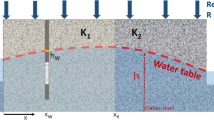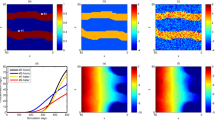Abstract
Spatial heterogeneity in groundwater system introduces significant challenges in groundwater modeling and parameter calibration. In order to mitigate the modeling uncertainty, data assiilation methods have been applied in the parameter estimation by assessing the uncertainties from both groundwater model and observations. In practice, the observations from groundwater system can be limited, and furthermore, boundary conditions and hydrogeological parameters, such as hydraulic conductivity, can be uncertain and biased. In order to handle the uncertain observations, this study applied the Bayesian maximum entropy (BME) for a data assimilation approach that integrates groundwater model, MODFLOW, and a variety of observations with uncertainties. In BME, no distributional assumption is imposed in the uncertain observations. We conducted numerical simulation with datasets of hard data of heads and hydrogeological parameters, uncertain head data on boundary, and uncertain hydrogeological parameters, i.e., hydraulic conductivity and storage coefficient. Three numerical scenarios with differerent combinations of datasets were conducted. Results show that the proposed data assimilation approach can gradually improve the modeling performance in the sense of lower mean squared errors over time. Moreover, the inclusion of uncertain observations can further improve the efficiency and accuracy in parameter estimation and hydraulic head prediction.












Similar content being viewed by others
References
Assumaning GA, Chang SY (2015) Application of sequential data-assimilation techniques in groundwater contaminant transport modeling. J Environ Eng 142(2):04015073
Basaran M, Erpul G, Ozcan A, Saygin D, Kibar M, Bayramin I, Yilman F (2011) Spatial information of soil hydraulic conductivity and performance of cokriging over kriging in a semi-arid basin scale. Environ Earth Sci 63(4):827–838
Batu V (1998) Aquifer hydraulics: a comprehensive guide to hydrogeologic data analysis. Wiley, Hoboken
Carrera J, Neuman SP (1986) Estimation of aquifer parameters under transient and steady state conditions: 2. Uniqueness, stability, and solution algorithms. Water Resour Res 22(2):211–227
Chang PY, Chang LC, Hsu SY, Tsai JP, Chen WF (2017) Estimating the hydrogeological parameters of an unconfined aquifer with the time-lapse resistivity-imaging method during pumping tests: case studies at the Pengtsuo and Dajou sites, Taiwan. J Appl Geophys 144:134–143
Chen Y, Zhang D (2006) Data assimilation for transient flow in geologic formations via ensemble Kalman filter. Adv Water Resour 29(8):1107–1122
Chen YC, Tsai JP, Chang LC, Chang PY, Lin H (2018) Estimating hydraulic conductivity fields in composite fan delta using vertical electrical sounding. Water 10(11):1620
Christakos G (2002) On the assimilation of uncertain physical knowledge bases: Bayesian and non-Bayesian techniques. Adv Water Resour 25(8–12):1257–1274
Christakos G, Serre ML (2000) Bme analysis of spatiotemporal particulate matter distributions in North Carolina. Atmos Environ 34(20):3393–3406
Christakos G, Hristopulos DT, Li X (1998) Multiphase flow in heterogeneous porous media from a stochastic differential geometry viewpoint. Water Resour Res 34(1):93–102
De Marsily G, Delay F, Goncalves J, Renard P, Teles V, Violette S (2005) Dealing with spatial heterogeneity. Hydrol J 13(1):161–183
Domenico PA, Schwartz FW et al (1998) Physical and chemical hydrogeology, vol 506. Wiley, New York
Douaik A, Van Meirvenne M, Tóth T, Serre M (2004) Space-time mapping of soil salinity using probabilistic Bayesian maximum entropy. Stoch Environ Res Risk Assess 18(4):219–227
Eggleston J, Rojstaczer S, Peirce J (1996) Identification of hydraulic conductivity structure in sand and gravel aquifers: Cape cod data set. Water Resour Res 32(5):1209–1222
Eppstein MJ, Dougherty DE (1996) Simultaneous estimation of transmissivity values and zonation. Water Resour Res 32(11):3321–3336
Franssen HH, Kinzelbach W (2009) Ensemble Kalman filtering versus sequential self-calibration for inverse modelling of dynamic groundwater flow systems. J Hydrol 365(3–4):261–274
Gallichand J, Prasher S, Broughton R, Marcotte D (1991) Kriging of hydraulic conductivity for subsurface drainage design. J Irrig Drain Eng 117(5):667–681
Gómez-Hernández JJ, Wen XH (1998) To be or not to be multi-Gaussian? A reflection on stochastic hydrogeology. Adv Water Resour 21(1):47–61
Hantush MM, Mariño MA (1994) Two-dimensional stochastic analysis and optimal estimation in aquifers: random recharge. Water Resour Res 30(2):559–569
Hendricks Franssen H, Kinzelbach W (2008) Real-time groundwater flow modeling with the ensemble Kalman filter: joint estimation of states and parameters and the filter inbreeding problem. Water Resour Res 44(9):W09408
Hoeksema RJ, Kitanidis PK (1984) An application of the geostatistical approach to the inverse problem in two-dimensional groundwater modeling. Water Resour Res 20(7):1003–1020
Højberg A, Refsgaard J (2005) Model uncertainty-parameter uncertainty versus conceptual models. Water Sci Technol 52(6):177–186
Journel AG, Huijbregts CJ (1978) Mining geostatistics, vol 600. Academic Press, London
Lee SJ, Balling R, Gober P (2008) Bayesian maximum entropy mapping and the soft data problem in urban climate research. Ann Assoc Am Geogr 98(2):309–322
Li B, Yeh TJ (1999) Cokriging estimation of the conductivity field under variably saturated flow conditions. Water Resour Res 35(12):3663–3674
Liu S, Yeh TJ, Gardiner R (2002) Effectiveness of hydraulic tomography: sandbox experiments. Water Resour Res 38(4):51–59
Neuman SP (2005) Trends, prospects and challenges in quantifying flow and transport through fractured rocks. Hydrol J 13(1):124–147
Panzeri M, Riva M, Guadagnini A, Neuman S (2013) Data assimilation and parameter estimation via ensemble Kalman filter coupled with stochastic moment equations of transient groundwater flow. Water Resour Res 49(3):1334–1344
Panzeri M, Riva M, Guadagnini A, Neuman SP (2014) Comparison of ensemble Kalman filter groundwater-data assimilation methods based on stochastic moment equations and Monte Carlo simulation. Adv Water Resour 66:8–18
Petrie RE, Dance SL (2010) Ensemble-based data assimilation and the localisation problem. Weather 65(3):65–69
Reichle RH (2008) Data assimilation methods in the earth sciences. Adv Water Resour 31(11):1411–1418
Serre M, Christakos G, Li H, Miller C (2003) A bme solution of the inverse problem for saturated groundwater flow. Stoch Environ Res Risk Assess 17(6):354–369
Tartakovsky DM, Winter CL (2008) Uncertain future of hydrogeology. J Hydrol Eng 13(1):37–39
Ting C, Zhou Y, De Vries J, Simmers I (1998) Development of a preliminary ground water flow model for water resources management in the Pingtung Plain, Taiwan. Groundwater 36(1):20–36
Troisi S, Fallico C, Straface S, Migliari E (2000) Application of kriging with external drift to estimate hydraulic conductivity from electrical-resistivity data in unconsolidated deposits near Montalto Uffugo, Italy. Hydrol J 8(4):356–367
Wackernagel H (2003) Multivariate geostatistics: an introduction with applications. Springer, Berlin
Wilson J, Kitanidis P, Dettinger M (1978) State and parameter estimation in groundwater models. In: Chiu L (ed) Applications of Kalman filter to hydrology, hydraulics, and water resources. University of Pittsburgh, Pittsburgh, pp 657–679
Xiang J, Yeh TJ, Lee C, Hsu K, Wen J (2009) A simultaneous successive linear estimator and a guide for hydraulic tomography analysis. Water Resour Res 45(2):W02432
Yeh TJ, Jin M, Hanna S (1996) An iterative stochastic inverse method: conditional effective transmissivity and hydraulic head fields. Water Resour Res 32(1):85–92
Yeh WW, Yoon YS (1981) Aquifer parameter identification with optimum dimension in parameterization. Water Resour Res 17(3):664–672
Yu HL, Lee CH, Chien LC (2016) A spatiotemporal dengue fever early warning model accounting for nonlinear associations with hydrological factors: a Bayesian maximum entropy approach. Stoch Environ Res Risk Assess 30(8):2127–2141
Zhou H, Gomez-Hernandez JJ, Franssen HJH, Li L (2011) An approach to handling non-Gaussianity of parameters and state variables in ensemble Kalman filtering. Adv Water Resour 34(7):844–864
Zhu J, Yeh TCJ (2005) Characterization of aquifer heterogeneity using transient hydraulic tomography. Water Resour Res. https://doi.org/10.1029/2004WR003790
Acknowledgements
This study was supported by funds from the Taiwan Ministry of Science and Technology (MOST 107-2625-M-002-020) and (MOST 108-2625-M-002-010).
Author information
Authors and Affiliations
Corresponding author
Additional information
Publisher's Note
Springer Nature remains neutral with regard to jurisdictional claims in published maps and institutional affiliations.
Rights and permissions
About this article
Cite this article
Yu, HL., Wu, YZ. & Cheung, S.Y. A data assimilation approach for groundwater parameter estimation under Bayesian maximum entropy framework. Stoch Environ Res Risk Assess 34, 709–721 (2020). https://doi.org/10.1007/s00477-020-01795-z
Published:
Issue Date:
DOI: https://doi.org/10.1007/s00477-020-01795-z




